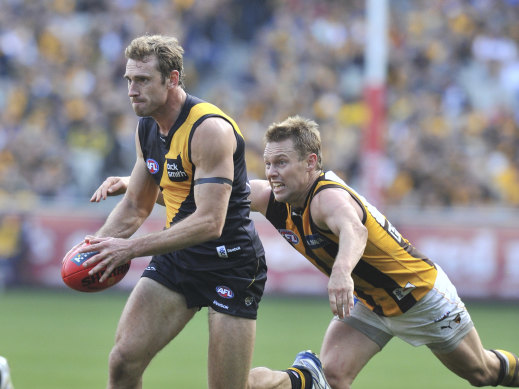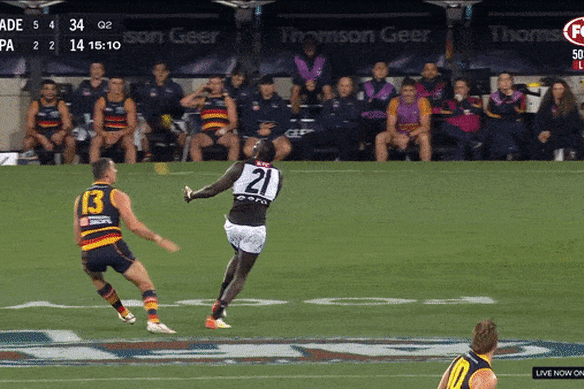This was published 1 year ago
Buckley backs big change to concussion rules after Tuck inquest
By Erin Pearson, Michael Gleeson and Jon Pierik
Independent doctors could remove AFL players from the field and clubs are being urged to slash the number of full contact training sessions before the 2025 pre-season as part of extensive concussion changes recommended by a coroner investigating the death of former Richmond player Shane Tuck.
State Coroner John Cain called on the AFL on Monday to limit the risk of significant head trauma to players during the on and off-season in the men’s and women’s games.

Tuck (left) on the field for Richmond in 2010.Credit: Joe Armao
Cain said the AFL should employ at all matches independent medical practitioners who would be empowered to remove players from the field for a medical assessment and overrule club doctors.
He also recommended that the league’s concussion spottersbe able to pull players from the field.
The AFL said it would review all recommendations, adding that the league had already made more than 30 changes to rules, the match review and tribunal guidelines over the past two decades to further protect the head.
Cain held an inquest into the death of Tuck, who took his own life in July 2020. Tuck, 38, had a decorated AFL career, playing 173 games with Richmond from 2004 to 2013.
Former Collingwood coach and champion player Nathan Buckley said cutting the number of full-contact training sessions was achievable without harming football programs.
Buckley said St Kilda coach Ross Lyon had already reduced contact drills.
“Philosophically, he does not want his players tackling and hitting in preparation and believed it was a game-day mindset. Mick [Malthouse] was down that way a bit,” Buckley said.
“Some programs it won’t affect at all; others have to make slight adjustments but with longer seasons [it is less of a concern]. It is achievable.”
Buckley said pre-season was when clubs did the bulk of their full contact training. “You might do a full contact session on Monday and Friday, so that could be cut to one a week,” he said.
Former Western Bulldogs and Sydney coach Rodney Eade said the recommendations were worthy but vague as they did not define a “contact” session.
He said it was more important for the AFL to now stipulate the number of defined contact sessions that clubs could run rather than a broad commitment to reducing the number of sessions, which already would vary greatly between different clubs.
Carlton captain and Brownlow medallist Patrick Cripps was not convinced of the need for independent concussion spotters to be given the power to remove players from the field for assessment after a heavy hit, and to overrule club doctors.
“We have a lot of trust in our medical staff that they make the right call based on our symptoms. They will never put us out there at risk,” Cripps said.

Port Adelaide teammates Aliir Aliir and Lachie Jones collide against Adelaide on Saturday night.Credit: Fox Footy
Another club source, who was not authorised to comment, said reducing contact sessions would not have a major effect on football preparation but also doubted it would have a significant effect on concussive incidents.
The source said the AFL would be obliged to adopt any recommendations or it would be more vulnerable to future legal action if it were argued the league had ignored the coroner’s advice.
Earlier this year Port Adelaide was fined $100,000 by the AFL for a breach of concussion protocols after admitting the doctor had not done a Scat5 concussion test on player Aliir Aliir before clearing him to return to play after a heavy accidental head clash with teammate Lachie Jones during the Showdown against Adelaide on the eve of the finals.
Last week Richmond champion Dustin Martin suffered a cut chin in an accidental collision with a teammate during match simulation. He was removed for monitoring for concussion.
Two years before his retirement, Tuck told a post-AFL season medical assessment he had suffered concussions. After football, he was involved in professional boxing from 2015 to 2017. He also suffered concussions in that sport, and was hospitalised.
The coroner heard that in the years before Tuck’s death he had begun hearing voices and withdrawing from family.
A postmortem examination found he had severe chronic traumatic encephalopathy at the time of his death – a type of brain degeneration thought to be caused by repeated head trauma.
Experts told the inquest the prevalence of CTE was not known in Australia as it could only be diagnosed after death.
An Australian Sports Brain Bank neuropathologist later found Tuck had the most severe case of CTE they had seen. Tuck is one of five former AFL footballers to be diagnosed with CTE after their deaths.
Others include Graham “Polly” Farmer, Danny Frawley and Murray Weideman.
It is estimated about 100,000 sports-related concussions occur each year in Australia, but most go undocumented and many occur in community sport.
Cain confirmed Tuck died with stage 3 CTE amid an ongoing mental health battle, following head injuries received during his boxing and football career.
He said clinical features of CTE, including those shown by Tuck before his death, could be used in the future to predict the presence of the condition before death.
“I convey my sincere sympathies to Shane’s family,” Cain said.
Counsel assisting the coroner, Gideon Boas, told the court one in five children would experience concussion, and 25 per cent of those would result from sport participation by the time they turned 10.
Initial symptoms of CTE can include issues with concentration and memory, impulsive behaviour, explosiveness, anxiety and depression.
On Monday, Cain also recommended the AFL develop standardised baseline neurological testing for all players and encourage past and present participants to consider donating their brains to the Australian Sports Bank for research.
Cain said the federal Health Department should also fund brain banks nationally.
If you or anyone you know needs support call Lifeline on 131 114.
The Morning Edition newsletter is our guide to the day’s most important and interesting stories, analysis and insights. Sign up here.